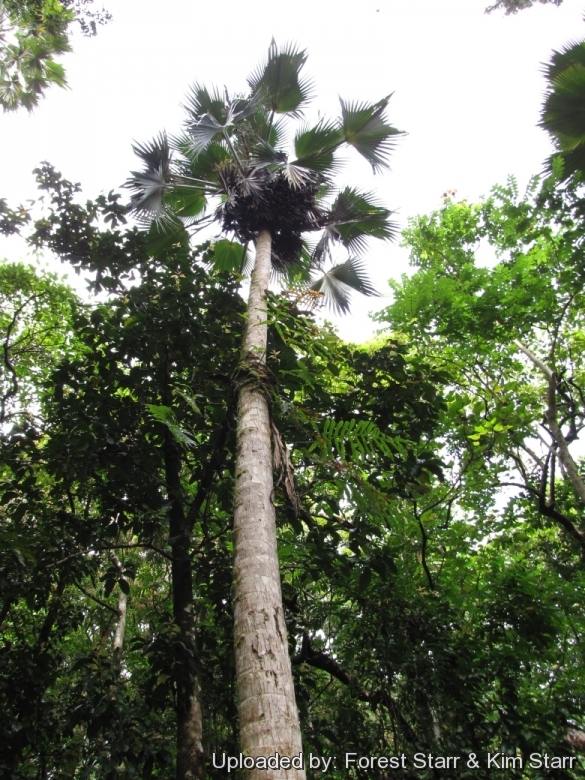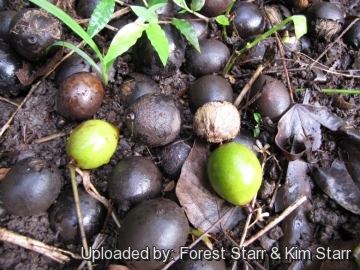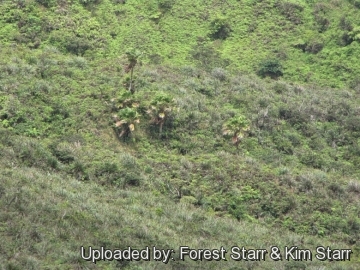
Pritchardia forbesiana Photo by: Forest Starr & Kim Starr
Habit at Keanae Arboretum, Maui, Hawaii (USA). February 16, 2012.
Origin and Habitat: Endemic to Molokaʻi and Maui, Hawaii islands, USA
Altitude: 300-1300 metres A.S.L.
Habitat: Pritchardia forbesianaSN|24624]]SN|24624]]is a palm tree frome West Maui (west Honokōhau drainage; north and east steep slopes and valleys of Mount ʻEke) in wet rainforest to mesic montane open forest.
Synonyms:
Common Names include:
ENGLISH: Mt. Eke pritchardia, Mt. Eke loulu, Hawaiian Fan Palm
HAWAIIAN (ʻŌlelo Hawaiʻi): Wāhane, Noulu, Loulu, Hāwane
Description: Pritchardia forbesianaSN|28635]]SN|24624]] is a small to medium sized palm tree.
Trunk: 3-9 m tall, columnar, naked, smooth or fibrous when young, grey, longitudinally grooved, and obscurely ringed by leaf scars.
Crown: Large, rounded of fan-shaped leaves.
Leaves (fronds): Quite large, lamina about 90 cm in diameter, coriaceous, wavy, strictly palmate (not costapalmate), semiciruclar stiff, slightly divided with pendulous tips, green above and below. Unlike many other Pritchardia, this one does not have the thick orangey fibres on the petioles and leaf bases and its leaves are rather green underneath. It does have a bit of a white hairy material that gives the petioles a mild glaucous appearance and the lower surface of leaf blades dotted with elliptic, slightly fringed to subentire, elongate-elliptic, yellowish scales.
Flowers: Three-petaled not showy, yellow, arranged in short panicles.
Fruit: The fruiting stalks, always with hairs, are as long as the leaves. Fruits are relatively large and at least 3 cm wide, nearly always longer than wide and brown to black when mature and ripe
Remarks: Pritchardia forbesianaSN|24640]]SN|24624]] is related to Pritchardia gordonii, Pritchardia lowreyana, Pritchardia munroiSN|24624]]SN|24640]], and Pritchardia schattaueriSN|24624]]SN|28635]].
Notes: The Hawaiian name “Loulu” is pronounced low-loo. Loulu means "umbrella," because the leaves were formerly used as protection from rain or sun. The names Hāwane and Wāhane can refer to either the fruits or the trees themselves.
Bibliography: Major references and further lectures
1) Wikipedia contributors. "Pritchardia forbesiana." Wikipedia, The Free Encyclopedia. Wikipedia, The Free Encyclopedia, 17 Mar. 2013. Web. 3 Sep. 2014.
2) Forest & Kim Starr Pritchardia forbesiana (Loulu). Plants of Hawaii. <http://www.starrenvironmental.com>. Downloaded on 21 August 2014.
3) Palmpedia contributors. "Pritchardia forbesiana." Palmpedia, PALM ENCYCLOPEDIA, <http://www.palmpedia.net> Downloaded on 26 Aug. 2014
4) Donald R. Hodel "Loulu-The Hawaiian Pritchardia" in the: The Palm Journal 193, page 12.
5) Native Plants Hawaii. “Pritchardia forbesiana” web 21 August 2014. >http://nativeplants.hawaii.edu/plant/view/Pritchardia_arecina>
6) David Leaser "Growing Palm Trees in Hawaiʻi and Other Tropical Climates"
Don Ellison, Anthony Ellison “Cultivated Palms Of The World” UNSW Press, 01/May/2001
7) Gemmill, C. 1998. Pritchardia forbesiana. The IUCN Red List of Threatened Species. Version 2014.2. <www.iucnredlist.org>. Downloaded on 03 September 2014.
8) "Hawaiian Dictionaries" http://www.wehewehe.org/
9) Donald R. Hodel "A Review of the Genus Pritchardia", page S-3, S-8, S-13.
 Fronds and fruit at Keanae Arboretum, Maui, Hawaii (USA). February 16, 2012. Photo by: Forest Starr & Kim Starr
Fronds and fruit at Keanae Arboretum, Maui, Hawaii (USA). February 16, 2012. Photo by: Forest Starr & Kim Starr Fruit on ground at Keanae Arboretum, Maui, (USA). February 16, 2012. Photo by: Forest Starr & Kim Starr
Fruit on ground at Keanae Arboretum, Maui, (USA). February 16, 2012. Photo by: Forest Starr & Kim Starr Habit at Waihee Ridge Trail, Maui, Hawaii (USA). July 22, 2011. Photo by: Forest Starr & Kim Starr
Habit at Waihee Ridge Trail, Maui, Hawaii (USA). July 22, 2011. Photo by: Forest Starr & Kim StarrSend a photo of this plant.The gallery now contains thousands of pictures, however it is possible to do even more. We are, of course, seeking photos of species not yet shown in the gallery but not only that, we are also looking for better pictures than those already present.
Read More... Cultivation and Propagation: It is an easy to grow palm that likes organic soil, but is adaptable to clay and loam both slightly alkaline and acidic. Good drainage is also important. Pritchardia forbesianaSN|24624]]SN|24624]] vary in shape. Specimens raised in dry and/or infertile soils tend to be smaller in stature with smaller leaves. Light also affects the plant's form while those grown in full sun are more compact. Tough they may be slow growing while young, once established, they will grow very fast.
Fertilization: Need a perfect fertilizer diet including all micro nutrients and trace elements or slow release fertilizer. Micronutrient deficiencies are occasional problems. If it doesn't get enough Mn and Fe, the leaves take on a rather unhealthy yellow colour. Micronutrient deficiencies only show up on soil with a high pH. Fertilize often for faster growth
Water Requirements: Needs regular water, do not let dry out between waterings. however it does not want to sit in continually wet, mucky soil. The roots and lower trunk can rot if soil is kept too moist.
Light: Prefers full sun but will tolerate half day sun. .
Hardiness: It is adapted to tropical and subtropical climates but tolerate temperatures down to about -4°C (for short periods) when mature, while young plants are more cold sensitive.
Maintenance: Prune diseased, damaged or drying fronds, but do not prune if the frond still has some green colour. Palms recycle nutrients from dead or dying fronds and use them for healthier fronds. Palms only have a set number of new leaves that can sprout and grow per year and removing fronds will not increase that number. If you cut off more than what will grow annually, you could be left with a pretty bare and bald palm.
Early Hawaiian Use The hard wood of the trunk were fashioned into spears. The trunks loulu were notched for climbing to gather the immature fruits and fronds. Older specimens still bear notches that can be seen today. The fronds were used for thatching and as plaiting such as papale (hats) and fans.
Food use: The young fruits called hāwane or wāhane are edible and can be eaten after being peeled. The flavour of fruit with the soft interior is similar to coconut.
Ornamental: It is cultivated as an ornamental tree, and planted in gardens and parks in tropical and sub-tropical climates either as a single specimen or in groups. Culture in containers is possible although growth rates are slower. A bright patio will provide an excellent environment for young specimens which can eventually be planted in a sunny location.
Propagation: Seeds. Because these palms easily hybridize with other Pritchardias, claiming a specific species requires seed collection from wild populations.












